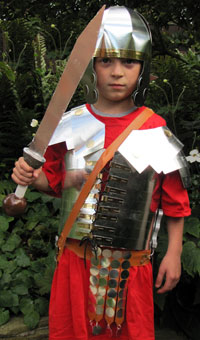
Latest News!
Welcome to a new section on the Time Trips website. Here you can keep up to date on what's going on with Time Trips, and other news and thoughts which may be of interest to teachers, children, and maybe even other people! I suppose this will be a sort of blog.
Saturday September 21, 2013
The school year is well under way and I have been getting more bookings than ever. Most of December is still free but I expect it to get filled up soon. I'm delighted of course to be so popular! I've given some of my new workshops already and they have gone well. Photos of children in the rocks and fossils, Roman art and Egyptian fashion days will be up soon(ish).
Roman Soldiers
I spent much of the summer developing the new afternoon session on roman soldiers, in which children will make up to 2 full sets of Roman weapons and armour. Some of these items were quite a challenge for me to work out - especially the armour - but I think they have turned out well and children will love making and wearing these items. Details are here, but below is a photo of some of the items, worn by my nephew Freddie.
House Move
Next week I'm moving to a new house. The address is 5, Mereland Avenue, Didsbury, Manchester M20 6SF. My wife Catherine and I are excited as it's a lovely house with lots of space and a beautiful garden. I'm looking forward to having a garage to do all the messy resource preparation - up to now I've been cutting wood and making statues and fossils out of plaster in my current house.
Greek Warfare Workshop Price Increase
I have just put up the price for the Greek Warfare workshop to £215. I have resisted doing this for a long time but it is now unavoidable. The price of the gold card used in the workshop has gone up enormously in recent years, and now they have started charging VAT which adds another 20%. I now spend about £30 per workshop just on the card which makes it very costly over the course of a year. I truly regret that I've had to do this, but I hope you will agree that £215 is still good value.
I've been told numerous times by teachers that my prices are very low, compared to many similar offerings. There are a few reasons for this. First, I work alone and so only have to pay myself. Second, I strongly believe in giving excellent value for money, and do not want children from less affluent areas to have to miss out on what I offer. Third, I have learned over the years where to get resources of high quality at reasonable prices. The gold card I buy is probably from the cheapest source in Britain - but it is still about £1.30 a sheet!
Thursday July 11th, 2013
New fossils!
Today is my birthday and my wife Catherine bought me two amazing fossils for the fossils workshop - here they are life size:


First is a tooth from a Spinosaurus, the largest land predator of all time. Its teeth were conical, adapted for catching fish. Next to it is a vertebra from a theropod. Theropods are a large group of dinosaurs that includes all the carnivores, like T rex and Velociraptor. In the lesson children will handle these fossils, plus a piece of dino eggshell and a lump of fossil dung, to illustrate the wide variety of fossil types.
The New Curriculum, again
I am delighted that the government has relented under pressure from many teachers and others including famous historians, and switched the new history curriculum back to something much closer to what it was before. I am especially relieved that ancient Egypt is back, and there is plenty on the Romans and Greeks. The new science curriculum also includes lots on rocks, fossils, and evolution (see below for a description of my new lessons on science topics).
More Fossils
I'm off to Whitby this weekend to collect lots of fossils for children to look at and buy. I'll be collecting a box of rocks and fossils for the fossil hunt activity (see below) and hopefully some very nice ammonites for the ID/drawing activity.
In August I'm off to the Isle of Wight for a week for even more fossil hunting!
I recently joined the Manchester Geological Association and will be going on lots of field trips and study days, to learn about geology and rocks. Last weekend I visited Lymm and Helsby Hill to learn about how sandstone was formed in the Triassic era, 250 million yerars ago. Sand dunes, formed by wind-blown sand, contains grains which are rounded, whereas river and beach sand is much more sharp-edged. Fascinating stuff!
Thursday June 27th, 2013
NEW! Rocks and Fossils option
From September the Fossils and Bones workshop will be split into three options (more details coming soon on the main page). These are the options:
Rocks and fossils: Children will learn about sedimentary and igneous rocks using pictures and actual rocks, and by a demonstration of how sedimentation occurs. They will play a game in which they have to identify a number of rocks (sandstone, limestone, granite, coal, shale, basalt, etc.).
We will then focus on fossils, first discussing what a fossil is and how it is formed. We will take a look at some dinosaur fossils (a tooth, bone, eggshell and dung) to show the variety of fossils that can come from one animal.
Next are two new activites, a concurrent fossil hunt and fossil ID game. These activities are designed both to teach the skills of a palaentologist and to bring the excitement of fossil hunting into the classroom.
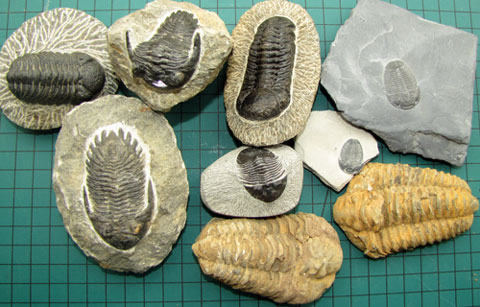
Trilobites used in the ID game
The class will be split into two. In one half, four teams will take part in the fossil hunt. They will turns searching through a box of rocks collected from a specific location in Britain, picking out what they think are fossils (with the aid of a photo guide). After 4 minutes each team gets a score for the number of fossils collected, minus one for each rock which is not a fossil.
The four locations/periods are: Whitby Jurassic coast (ammonites, belemnites, shells etc.); Welsh Carboniferous coral reef (corals, brachiopods, crinoids etc.); New Hey Quarry Carboniferous plants and river bed (horsetails, ripple marks, fish rtace marks etc.); Dudley Silurian coral reef (corals, trilobites, brachiopods etc.)
The other half of the class, also in 4 teams, will do the fossil ID activity. They will have a collection of different species of one type of fossil - ammonites on one table, trilobites on another, and plants and corals on the others. They will pick one of the fossils and using a picture guide identify the species. They will then draw the fossil as accurately as possible. At the end I will give free fossils to the four children who do the most accurate drawings and identifications.
In the afternoon, children will do the fossil game and fossil painting from the original Fossils and Bones workshop.
Fossils and Bones: This is the original workshop. We start by looking at dinosaur fossils, and then children handle three fossils. This is followed by the fossil game, and after break the fossil painting.
In the afternoon we learn about the human skeleton and how a dinosaur has the same bones, by looking at a model skeleton and naming the bones, then looking at a colour coded picture of a dinosaur skeleton. Then we spend most of the afternoon making skeleton pictures, with three options: 3 small creatures (Plesiosaurus, Deinonychus and Pteranodon), 1 large dinosaur (T rex or Triceratops), or 8 skulls.
Skeletons and Bones: If you are studying the Growth and Movement unit you may wish to focus more on bones. In this case we will start by looking at the model skeleton and spend more time learning the bones, looking at a couple of dinosaur skeletons and identifying their bones. Then we will play the bone game, with teams handling and identifying 15-20 animal bones (depending on age of the class).
After break we will do the fossil painting, or if you prefer, the fossil game. Many of the fossils are of bones, teeth, or full skeletons, and are useful for learning about skeletons. Some of the fossils have exoskeletons (crab, trilobite, ammonite etc.)and we can discuss how this is a different approach evolution has taken to providing protection and support to an animal's body.
After lunch we will do the skeleton making, with a slightly longer introduction to the animal(s) we will be making and a look at their skeletons.
The New Science Curriculum which begins in 2014 appears to have dropped the unit on skeletons, so I expect the Skeletons and Bones option will be chosen less often, but it will still be available.
Saturday June 1st, 2013
New Egyptian Options
From September I will have two options for afternoon session of the Gods and Pharaohs workshop. I am currently creating new artefact making activities for these two new options.
Below is a copy of Tutankhamun's falcon pectoral, an amazing work of art which tells us a lot about the Egyptians' religious beliefs (it represent the sun god carrying two symbols meaning eternity, as well as the sign for life, ankh.) This is a challenging artefact for the most able children in your class to make.

Copy of Tutankhamun's falcon pectoral which 2 children can make
The two new options are Egyptian fashion and gods and pharaohs. For the fashion option children will learn about styles of bodily adornment, including jewellery, clothes, make up and perfume, by looking at replicas and seeing two children dress up. They will also get to smell (at least) three of the Egyptians' favourite scents - frankincense, myrrh, and blue lotus (the lotus is an ever-present symbol in Egyptian art, representing fertility and rebirth).
After this children will make a variety of jewellery, as well as two items bearing the head of the goddess of beauty, Hathor - the mirror and sistrum (a musical instrument). As well as the above pectoral, I am developing new artefacts including collars (a very important type of Egyptian jewellery), bracelets, and necklaces with pendants.
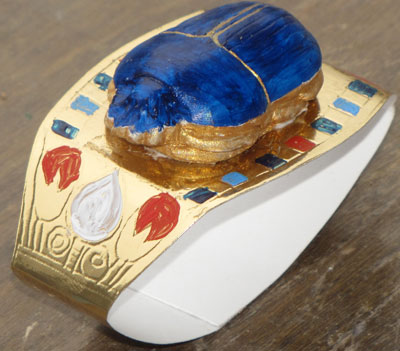
Copy of Tutankhamun's scarab bracelet which children will make
For the gods and pharaohs option, the focus will be on pharaohs but with frequent mention of the gods, as well as burial and the afterlife. Over the last few months I have been allowing children to choose whether to focus on the gods or pharaohs in the Egyptian workshop. Nine times out of ten they have chosen pharaohs, which is why the main focus from now on will be on pharaohs. If you would prefer to focus on the gods you can let me know.

A model of Tutankhamun's mask children will paint
In the afternoon we will first dress up two children, then look at artefacts, then make artefacts. The artefacts include statuettes (gods, pharaohs, Tutankhamun's coffin, and a new one, a bust of Tutankhamun's mask), some of Tutankhamun's and other pharaohs' jewellery (bracelets, pectorals and a collar - see below), Tutankhamun's dagger, an obelisk, and papyrus paintings. The papyrus paintings will now be larger (A4, and one A3 size) and the lines will be printed so children only have to colour them in. This means the final products will be much more impressive, and I believe children will enjoy doing them more.

Copy of one of Tutankhamun's collars which a group of children will make
The New Curriculum
As you probably know, the government is planning to radically change the history curriculum for KS2 from September 2014. As part of this they want to drop ancient Egypt. This is bad news for me of course as I do a lot of Egyptian workshops. I also think it is bad for children, as ancient Egypt is universally their favourite history topic, and it serves to encourage an interest in history and other cultures. The government is now reviewing these changes and taking feedback from educators. If you agree that Egypt should not be dropped, I hope you will lodge your protest. Information is on the government's website:
You can email your feedback to them at:
NationalCurriculumReview.feedback@education.gsi.gov.uk
If Egypt is dropped, I will spend my free time next year working on a replacement history topic. I am thinking of doing something on the Stone Age - cave paintings and the like. If you have any suggestions they would be more than welcome: tnorth67@hotmail.com.
NEW MONSTERS!
Below I discussed how I have developed three new skeletons for the fossils and bones workshop. I tried these out recently at Hursthead Primary in Cheadle and All Saints' in Sale. After a little refinement these activities are now in great shape. The children produced some excellent artwork which you can see here. An example is below.
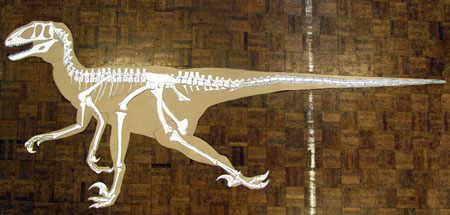 Deinonychus
(3m long)
Deinonychus
(3m long)
I have now modified the fossils and bones workshop slightly (details here). I have found on many occasions that there is not enough time to finish the skeletons in the afternoon. I feel it is important to get all projects in a Time Trips workshop finished on the day, as far as is possible. The schedule of the workshop has now changed, therefore. The afternoon will be devoted only to the skeleton making, with a brief introduction to the animals at the start, to give some context.
If you would like a focus on skeletons and the different types of bones, we will do that in the morning, and if you like we can do the bone game instead of the fossil game, as well as looking at the skeleton model and learning about the different bones in our own bodies as well as in animals. The main morning activity will still be fossil painting, which includes many bones, teeth, and skeletons, and so is still a useful way to learn about skeletons.
Future Science Plans
Like history, the science curriculum is set to change in 2014. The Growth and Movement unit will be dropped, but there will still be units on rocks and fossils, evolution, adaptation, and classification of animals and plants, all of which are well served by my fossils and bones workshop. One interesting new section is on the evolution of the human skeleton, so I may develop an activity based on this (e.g. looking at, classifying, and making hominin skulls). This would also tie in nicely with studies of the Stone Age.
I welcome any feedback on whether workshops on evolution and adaptation would be of interest to you: tnorth67@hotmail.com.
Saturday April 27th, 2013
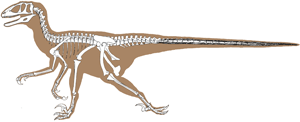 Deinonychus
Deinonychus
New dinosaurs - I am currently working on three new skeletons for the Fossils and Bones workshop. Many schools do not have enough wall space to display the huge T rex (12m X 4m) or Triceratops (8m X 3m), but they do want to make full skeletons, rather than the skulls. This is why I now have these three new, smaller skeletons (each around 3.5m long). They are just as scary, cool, and fascinating as the big dinos. Follow the link to see some more pictures.
The new monsters are Deinonychus, Plesiosaurus, and Pteranodon. Strictly speaking only Deinonychus is a dinosaur. Plesiosaurus was a sea reptile with a very long neck, similar to Nessie, and Pteranodon was a flying reptile with a long beak. The velociraptors in Jurassic Park were actually based on Deinonychus - real velociraptor were much smaller. I'm guessing the filmmakers thought 'Velociraptor' sounded a lot cooler and easier to pronounce than 'Deinonychus'!
Over Easter I went to Italy with my wife Cathy. We had an amazing time - there is an incredible number of stunning works of art and historically important buildings over there. The most famous are the Colosseum and Pompeii, the city buried beneath the ash spewed from Mount Vesuvius in AD79. We saw both these and lots more, and of you want to see the photos, follow the link. I bought a couple of small sculptures which will soon be part of the Romans workshop as artefacts children can paint.
